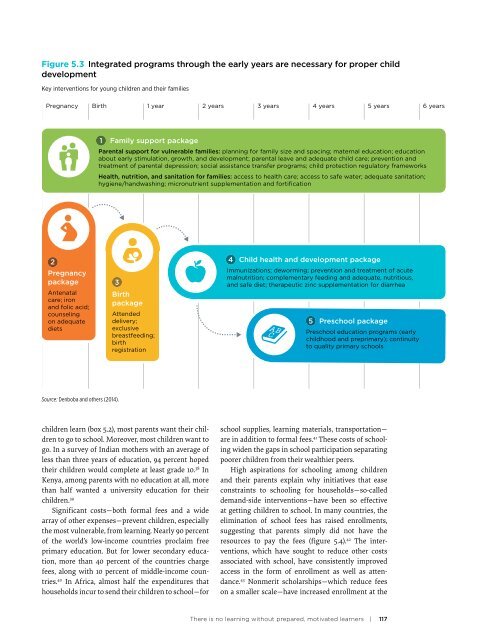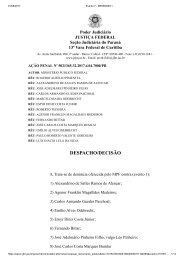Brasil só deve dominar Leitura em 260 anos, aponta estudo do Banco Mundial Relatorio Banco Mundial _Learning
Create successful ePaper yourself
Turn your PDF publications into a flip-book with our unique Google optimized e-Paper software.
Figure 5.3 Integrated programs through the early years are necessary for proper child<br />
<strong>deve</strong>lopment<br />
Key interventions for young children and their families<br />
Pregnancy Birth 1 year 2 years 3 years 4 years 5 years 6 years<br />
1 Family support package<br />
Parental support for vulnerable families: planning for family size and spacing; maternal education; education<br />
about early stimulation, growth, and <strong>deve</strong>lopment; parental leave and adequate child care; prevention and<br />
treatment of parental depression; social assistance transfer programs; child protection regulatory frameworks<br />
Health, nutrition, and sanitation for families: access to health care; access to safe water; adequate sanitation;<br />
hygiene/handwashing; micronutrient suppl<strong>em</strong>entation and fortification<br />
2<br />
Pregnancy<br />
package<br />
Antenatal<br />
care; iron<br />
and folic acid;<br />
counseling<br />
on adequate<br />
diets<br />
3<br />
Birth<br />
package<br />
Attended<br />
delivery;<br />
exclusive<br />
breastfeeding;<br />
birth<br />
registration<br />
4 Child health and <strong>deve</strong>lopment package<br />
Immunizations; deworming; prevention and treatment of acute<br />
malnutrition; compl<strong>em</strong>entary feeding and adequate, nutritious,<br />
and safe diet; therapeutic zinc suppl<strong>em</strong>entation for diarrhea<br />
AB<br />
C<br />
5 Preschool package<br />
Preschool education programs (early<br />
childhood and preprimary); continuity<br />
to quality primary schools<br />
Source: Denboba and others (2014).<br />
children learn (box 5.2), most parents want their children<br />
to go to school. Moreover, most children want to<br />
go. In a survey of Indian mothers with an average of<br />
less than three years of education, 94 percent hoped<br />
their children would complete at least grade 10. 38 In<br />
Kenya, among parents with no education at all, more<br />
than half wanted a university education for their<br />
children. 39<br />
Significant costs—both formal fees and a wide<br />
array of other expenses—prevent children, especially<br />
the most vulnerable, from learning. Nearly 90 percent<br />
of the world’s low-income countries proclaim free<br />
primary education. But for lower secondary education,<br />
more than 40 percent of the countries charge<br />
fees, along with 10 percent of middle-income countries.<br />
40 In Africa, almost half the expenditures that<br />
households incur to send their children to school—for<br />
school supplies, learning materials, transportation—<br />
are in addition to formal fees. 41 These costs of schooling<br />
widen the gaps in school participation separating<br />
poorer children from their wealthier peers.<br />
High aspirations for schooling among children<br />
and their parents explain why initiatives that ease<br />
constraints to schooling for households—so-called<br />
d<strong>em</strong>and-side interventions—have been so effective<br />
at getting children to school. In many countries, the<br />
elimination of school fees has raised enrollments,<br />
suggesting that parents simply did not have the<br />
resources to pay the fees (figure 5.4). 42 The interventions,<br />
which have sought to reduce other costs<br />
associated with school, have consistently improved<br />
access in the form of enrollment as well as attendance.<br />
43 Nonmerit scholarships—which reduce fees<br />
on a smaller scale—have increased enrollment at the<br />
There is no learning without prepared, motivated learners | 117








